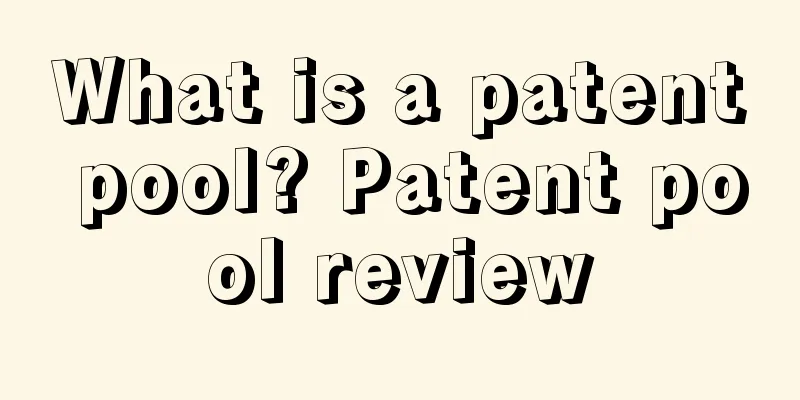What is a patent pool? Patent pool review

|
Patent Pool: It is a patent licensing trading platform composed of patent holders. On the platform, patent holders conduct horizontal licensing among each other, and sometimes open to third parties for horizontal and vertical licensing under unified licensing conditions. The licensing rate is determined by the patent holder. There are still patent licensing issues between the various patent holders on the "patent pool" (joint licensing) platform. Classification of patents Overview Patent pools were originally agreements between two or more patent owners to license one or more patents to one party or a third party. Later, they evolved into "a collection of intellectual property rights formed by putting multiple intellectual property rights, mainly patent rights, as cross-licensing objects into a package license." The original intention of the patent pool was to speed up patent licensing and promote technology application. The management of patent pools is the pricing of standards and is a key link in industrial alliances. It not only affects the interests of alliance members, but also affects end users and directly determines the development of standards. Development History Tracing the source In 1856, the first patent pool appeared in the United States - the Sewing Machine Alliance, which included almost all the holders of sewing machine patents in the United States at that time. In 1908, four companies, Armat, Biograph, Edison and Vitagraph, reached an agreement to form a patent pool to centrally manage all patents of the early animation industry. Licensees, such as film exhibitors, had to pay designated patent royalties to the patent pool. In 1917, when the United States participated in the First World War, a large number of aircraft were urgently needed. However, the main patents related to aircraft manufacturing were in the hands of Wright and Curtiss, which effectively restricted aircraft production. Therefore, the US government stepped in to promote the formation of a patent pool among various aircraft manufacturers to reduce patent barriers and expand aircraft production. By the end of the 19th century, patent pools were already very common in the United States. However, the development and growth of patent pools began to encounter more and more controversy. Opponents believe that patent pools may lead to monopoly and unfair competition, and that patent pool members often collude with each other to exclude competitors, control market prices, and charge unreasonable fees for non-essential or even invalid patents. In 1912, the U.S. Supreme Court ruled in the case of Standardsanitary manufacturing co., ltd. v. united states that the practice of fixing sales prices by the sanitary products patent pool violated the Sherman Act. In 1945, Judge Hugo Black even claimed in the Hartford-Empire case: There may never be an economic tyranny in the history of the United States that has successfully dominated the industry like this patent pool. The courts made unfavorable decisions to patent pools in a series of cases such as Hartford-Empire and New Wrinkle, and the development of patent pools fell into a trough. This situation did not begin to change until the 1990s. Cause The emergence of patent pools is an inevitable product of the combination of technological development and the patent system. Despite constant controversy, both supporters and opponents do not deny that the existence of patent pools has a positive effect. The most important role of patent pools is that they can eliminate the authorization barriers in patent implementation and facilitate the promotion and application of patented technologies. There are three types of relationships between different patents: barrier relationship, complementary relationship and competitive relationship. Barrier patents often arise between prior basic patents and subordinate patents developed based on them. Subordinate patents cannot be implemented without basic patents. On the contrary, basic patents are often difficult to commercialize without the assistance of subordinate patents. Therefore, cross-licensing between barrier patents is very necessary. Complementary patents are generally independently developed by different researchers. The two are interdependent and each forms an inseparable part of a certain product or technical method. Like barrier patents, complementary patents also need to be authorized to play a role. Competitive patents (substitute patents) refer to patents that can replace each other in the process of implementing a certain invention. The two are either one or the other rather than interdependent. For competitive patents, it is generally believed that if they exist in the same patent pool, they will cause monopoly problems. Therefore, excluding competitive patents from entering patent pools has become one of the important contents of the antitrust authorities' review of patent pools. As for obstructive patents and complementary patents, if they are placed in the same patent pool, it will eliminate the barriers to mutual licensing between patents, thereby promoting technology promotion. On January 19, 2001, the United States Patent and Trademark Office (USPTO) issued the "Patent Pool White Paper", suggesting the use of patent pools to overcome the barriers in biotechnology patent licensing. The white paper believes that "patent pools will help promote the acquisition of biotechnology patent technologies, thereby promoting research and development and promoting competition through patent granting." Another significant effect of patent pools is that they can significantly reduce transaction costs in patent licensing. Patent pools implement one-stop package licensing for other manufacturers and adopt unified standard licensing agreements and charging standards, so that licensed manufacturers do not have to conduct lengthy patent licensing negotiations with each member of the patent pool separately, which greatly saves the transaction costs of both parties. Patent pools can also reduce patent disputes and reduce litigation costs. Patent disputes between patent pool members can be resolved through internal negotiations without going to court. The list of patents owned by the patent pool and the list of licensed manufacturers will be made public. Once a manufacturer infringes on patent rights, it will be easy to find out, and the occurrence of indirect infringement will also be reduced. The reduction of patent infringement means the reduction of patent litigation. Moreover, even if a patent dispute occurs, the patent pool as a whole participates in the litigation on behalf of the patent pool members, which can greatly simplify the litigation process. Since the cost of patent litigation is high, often millions of dollars, the patent pool form can greatly save the litigation costs of both parties to the litigation, not only reducing the burden on enterprises, but also avoiding the huge waste of social legal resources. The above-mentioned positive effects of patent pools have enabled their emergence and development. Especially today, modern patent pools have begun to grow and their industrial impact has become increasingly widespread. Rise Again In 1997, the MPEG-2 patent pool based on the MPEG-2 digital video compression standard was established, including nine members such as Columbia University, Fujitsu, Lucent, and Sony. The patent pool controls the global MPEG-2 standard digital video compression industry. Competitors accused the US Department of Justice of violating the "Antitrust Guidelines for Intellectual Property Licensing", but the Department of Justice ultimately determined that the patent pool did not constitute a monopoly. After that, DVD 3C and DVD 6C were established one after another, and their industrial influence spread all over the world. In its commercial review letter to the two DVD patent pools, the US Department of Justice pointed out that although they had flaws in the expert review mechanism, "there is no potential to hinder competition." The European Union also approved the two patent pools one after another. Recently, patent pools involving 3G communications, digital television, new generation DVDs, biopharmaceuticals and other industries are also being formed. Since the 1990s, governments and courts in Europe and the United States have begun to change their past prejudices against patent pools and re-evaluate them. In 1995, the U.S. Department of Justice and the Federal Trade Commission jointly issued the Antitrust Guidelines for Intellectual Property Licensing, which clearly pointed out that cross-patent licensing and patent pools under certain conditions are conducive to competition. Since then, the U.S. Department of Justice and relevant EU agencies have successively approved important patent pools such as MPEG-2, 1394, DVD 3C, and DVD 6C. In January 2001, the U.S. Patent and Trademark Office (USPTO) publicly justified patent pools in its "Patent Pool White Paper", arguing that "patent pools in the field of biotechnology will benefit both the public and private enterprises", and the final conclusion is that "patent pools, especially in the field of biotechnology, can create more innovation and parallel research and development, eliminate patent bottlenecks and accelerate product development." Basic Features 1. Have a clear, well-defined standard; 2. Have a process or third-party experts to decide which patents are core; 3. A technology license drafted and approved by the core patent holder, which should at least be based on the reasonable and non-discriminatory principle (i.e., FRAND principle); 4. The patent pool management organization is jointly appointed by the core patent holders and is responsible for the management of the patent pool; 5. Core patent holders reserve the right to license their own patents outside the patent pool. The unreasonable management of patent pools has directly led to multi-party resistance to standards. A reasonable management model directly affects the progress of a standard, which is a link that our domestic industry alliance must handle well. Reasons for the rise The resurgence of modern patent pools has profound economic and technological backgrounds. It adapts to the new trend of increasingly strengthened technological development and technical standards under global integration. 1) Patent barriers caused by “patent thickets” need to be eliminated by patent pools The complexity of modern science and technology is no longer the same as before. The number of patents involved in a product is becoming increasingly dense, resulting in the so-called "patent thicket" phenomenon. The "patent thicket" has greatly increased the risk of numerous patents forming obstacles to each other, prompting patent holders to form patent pools to ensure that patents can be implemented smoothly. 2) The refinement of industrial division of labor and the continuous extension of the industrial chain have created a patent pool As the division of labor becomes more and more detailed and the industrial chain continues to extend, the number of manufacturers gathered in a certain industry is far greater than in the past, and the technical correlation between upstream and downstream companies is also getting higher and higher. In this case, if there is no patent pool, the transaction cost of many companies seeking patent licenses individually will be very staggering, and the one-stop package licensing method of the patent pool is undoubtedly the most efficient choice. 3) Industrial technology standardization has given rise to patent pools In the context of global integration, along with the influence of the network effect of technical standards, the role and status of industrial technical standards have become increasingly prominent in recent years. The competition of technical standards has become the commanding height of world industrial competition. Modern industrial technical standards are often combined with patents, and the formation process of technical standards is also accompanied by the formation process of patent pools. Once a technical standard is established, the licensing issues of the large number of patents contained in the standard may become complicated and become a stumbling block to the promotion of the standard. At this time, the best way to solve this problem is for relevant patent holders to form a patent pool. Whether it is MPEG-2, DVD or 3G standards, forming a patent pool has become an indispensable and important part of the promotion of standards. 4) The shortening of modern technology cycles has accelerated the formation of patent pools Modern science and technology are developing at a rapid pace, and the replacement of technology is accelerating. If a technology cannot be industrialized quickly, it will soon become obsolete, not only unable to make a profit, but even unable to recover the R&D costs. However, the process of technology industrialization is often hindered by the time-consuming and laborious patent licensing process, and people have to use patent pools to quickly solve this problem. For example, the DVD-3C Alliance was established because Philips, Sony and Pioneer could not wait for the long patent negotiations and were worried about missing the opportunity to develop the DVD industry. Establishment and operation Unlike the past technical standards that usually excluded patent rights, modern patent pools often contain a large number of patent technologies. Patent pools are increasingly becoming patent licensing platforms for the implementation of technical standards. The formation and operation of modern patent pools vary due to differences in industry, region and other factors, but generally follow the following path. Form technical standards and form patent pools According to the different formation processes of technical standards, technical standards can be divided into de jure standards and de facto standards. De jure standards refer to technical standards formulated or confirmed by the government and its authorized standardization organizations or international standardization organizations. De facto standards refer to technical standards that are not formulated by standardization organizations, but by enterprises or enterprise groups in a leading position in technology (some also need to be recognized by industry alliance organizations, such as DVD standards need to be recognized by DVD Forum), and are actually accepted by the market. As the technologies included in technical standards are becoming increasingly complex and the research and development of technologies requires huge investments, there are risks in whether the research and development can be successful and whether they can be accepted as standards. Therefore, the situation where a few enterprises independently develop and form technical standards will become less and less, and enterprises are more willing to form technical alliances to jointly promote technical standards. At present, the formation of technical standards, whether statutory standards or de facto standards, mostly begins with some enterprises forming technical alliances to jointly develop and launch candidate technical standards, and then they are adopted as statutory standards by the government or standardization organizations or accepted as de facto standards by industry alliances. This kind of technical alliance can be said to be the prototype of a patent pool. Once the technology jointly developed by the technical alliance becomes a technical standard, the patent pool is formed on this basis. Take the WCDMA standard, the most mature of the three major international standards for 3G, for example. WCDMA technology was jointly developed by Europe and Japan, and was later accepted as an international standard by the International Telecommunication Union (ITU). In November 2002, NTT DoCoMo, Ericsson, Nokia and Siemens, four companies that own the main patents of WCDMA, jointly proposed a patent licensing plan and promised to license to others under fair and reasonable conditions. The licensing rate for WCDMA basic patents is proportional to the number of basic patents owned by each company, and the cumulative patent rate will not exceed 5%. Subsequently, Fujitsu, Panasonic, Mitsubishi Electric, NEC and Sony of Japan expressed their willingness to join the plan, and the WCDMA patent pool was initially formed. Evaluate essential patents and build patent pools A standard or technology may involve many patents, but only the essential patents can eventually enter the patent pool. This is not only the policy of the standardization organization, but also the requirement of the antitrust departments of various countries. Before building a patent pool, patent evaluation is generally required to determine which patents are essential patents that can be included in the patent pool. Once a patent technology is selected as an essential patent, the patent owner can obtain cross-licensing and share the benefits of external licensing. Therefore, the results of the patent evaluation are of great importance to each patent owner. In order to ensure the fairness and rationality of the evaluation results, the evaluation work is generally carried out by an independent third party. The results of the evaluation are not static. With the changes in patent authorization and technology, the evaluation agency needs to continuously track and evaluate the technology. Patents that have expired will be removed from the patent pool, and newly authorized essential patents will be added. Therefore, the number of patents in the patent pool will continue to change, and the members of the patent pool will also be adjusted. Generally speaking, the number of patents in the patent pool and the number of patent pool members will gradually increase. Taking the MPEG-2 patent pool as an example, the essential patents of MPEG-2 are evaluated by experts organized by MPEG-LA, an independent patent management organization established by the patent pool member agreement. MPEG-LA initially searched more than 8,000 US patent abstracts and evaluated more than 800 patents owned by more than 100 patent owners. Finally, 27 patents were determined to be essential patents to form the patent pool. Later, with the participation of companies such as France Telecom and Hitachi, the number of patents in the patent pool increased to 230. The evaluation of the essential patents of the WCDMA Alliance is carried out by an independent third-party organization, the International Patent Evaluation Association (IPEC). The association is jointly composed of 13 international patent law companies from China, Japan, South Korea, Britain, France, Italy, Germany, and the United States. Patent evaluation is carried out according to the methods defined by the industry, and each evaluation is undertaken by three patent lawyers. The evaluation process must be credible and recognized by the industry. Formulate intellectual property policies and establish intellectual property management agencies The intellectual property policy of a patent pool is generally formulated through consultation among the members of the patent pool, but it is also affected and restricted by many factors. In addition to meeting the requirements of antitrust regulations, it is also subject to the relevant policies of standardization organizations, and is even directly formulated by standardization organizations. The intellectual property policy of a patent pool mainly includes the basic principles of intellectual property licensing, licensing fee standards, and licensing methods, etc. The content of its intellectual property licensing mainly involves patents, and some also include trademarks (such as logos used as certification trademarks) and copyright objects (such as technical manuals). Patent licensing principles The principle of equality is usually followed within the patent pool. The status of patent pool members is equal regardless of the number of patents they hold. Every essential patent is also treated equally regardless of its role, because any patent in the patent pool is essential for the implementation of the technology. Members generally cross-license with each other, and the external licensing income is mainly distributed in proportion to the number of patents owned by each member. Patent pools' external patent licensing generally abides by the "FRAND (Fair, Reasonable and Non-discriminatory) principle". That is, the "fair, reasonable and non-discriminatory principle", which is also the principle requirement of many standardization organizations and antitrust agencies. The principle of fairness requires that patent pools should not refuse to license without reason to restrict the entry of new manufacturers; the principle of reasonableness requires that the licensing terms, especially the patent licensing rate, should be reasonable; the principle of non-discrimination requires that patent pools should treat any licensed manufacturer equally and should not favor one over another or refuse to license because of reasons such as country of origin or size. For example, standardization organizations such as 3GPP, ETSI, and CWTS have stipulated the FRAND principle of licensing in their intellectual property regulations. Patent licensing fee standards Patent pools generally implement a unified charging standard for external licensing, which is also a reflection of the principle of non-discrimination. In order to determine a reasonable patent charging standard and the distribution ratio among patent pool members, the patent pool needs to determine a set of calculation methods for collecting and distributing patent licensing fees. These methods generally include the cost accumulation method (Cost Approach), the market price comparison method (Market Approach), the income estimation method (Income Approach), etc. In practice, the patent licensing fee rate usually does not exceed 5% of the net selling price of the patented product. Today, as standardization organizations are becoming increasingly powerful, the intellectual property licensing fees of patent pools are often limited in advance by standardization organizations. For example, the 3G standardization organization "3rd Generation Partnership Project" 3GPP attempts to play a coordinating role between patent owners and 3G manufacturers, not only organizing the evaluation of necessary patents, but also formulating the calculation method of patent fees and limiting the maximum patent fee rate. Intellectual Property Management Agency Patent pools usually implement one-stop package licensing for external parties, and a special intellectual property management agency is responsible for related affairs. The management agency not only fully represents the patent pool in unified external licensing, but also handles patent dispute negotiations and litigation matters. There are generally two ways to establish a management agency: one is that the patent pool sets up an independent entity specifically responsible for intellectual property management. The patent pool members first sign a patent licensing agreement with the independent entity, and then the independent entity is responsible for intellectual property licensing matters. For example, MPEG-LA established by the MPEG-2 patent pool and DVD6C-LA established by the DVD-6C patent pool are such independent entities, both of which are in the form of limited liability companies; the other is not to set up an independent agency, but to entrust some of its members to be responsible for intellectual property management on behalf of the patent pool. DVD-3C adopts this method. The patent pool entrusts Philips, one of its members, to be responsible for intellectual property licensing matters. What to do Modern patent pools are the product of the combination of intellectual property rights and technical standards. This combination gives patent pools extremely strong market dominance and increases the risk of abuse of intellectual property rights. In the face of challenges from foreign patent pools, we should address them from the following aspects. 1) China should speed up the establishment of an antitrust mechanism to regulate patent pools The Anti-Monopoly Law has been promulgated, and it is advisable to add provisions to regulate patent pools in the Patent Law, Patent Law Implementing Regulations and related legal interpretations. In addition, we should learn from the experience of the United States, formulate corresponding administrative regulations and clarify relevant regulatory agencies, regulate the activities of patent pools in China, and change the current situation of "lawlessness" of foreign patent pools in China. 2) Strengthen coordination among relevant enterprises and between enterprises and the government Practice has proved that if enterprises unite to negotiate patent rates and licensing terms with foreign patent pools, the effect is often much stronger than that of enterprises fighting alone. Therefore, the role of industry associations, enterprise alliances and relevant government agencies should be actively brought into play. For example, the China Electronic Audio Industry Association (CAIA) once represented Chinese DVD companies in the DVD patent pool fee negotiations, and the Ministry of Information Industry's Telecommunication Research Institute represented Chinese companies in the patent pool fee negotiations for the third-generation mobile communication standard. Speaking with one voice will undoubtedly increase our power at the negotiation table. 3) Enterprises should strengthen independent innovation We strive to make breakthroughs in the research and development of core technologies and obtain more independent intellectual property rights to enhance our voice in technical standards and patent pools. By mastering core technologies through independent innovation, we can bypass foreign patent pools or join patent pools to obtain cross-licensing. Only in this way can we completely change the passive situation and fundamentally curb the abuse of intellectual property rights by foreign patent pools. References |
<<: What is the International Trade Center? International Trade Center Review
>>: What is the Law of the Patent Jungle? Evaluation of the Law of the Patent Jungle
Recommend
U.S. Trademark Office to Prioritize Trademark Applications for COVID-19-Related Goods and Services
The United States Trademark Office (USPTO) has ju...
What is Focus Leading? Focus Leading Review
Nanjing Focus Leading Cloud Computing Technology C...
What is Seller Hub? Seller Hub Review
Seller Hub is a new seller sales tool launched by ...
What is Xiaofeixia Logistics? Xiaofeixia Logistics Review
Shenzhen Xiaofeixia Modern Logistics Information T...
Official backend release notice! Amazon sellers seize the opportunity to report
In the past two days, some sellers revealed that A...
What is Rank-Booster? Rank-Booster Review
Rank-Booster is a platform that helps sellers incr...
How can Amazon sellers quickly accumulate their own review resources on Facebook?
Many Amazon veterans should know how important rev...
What is AMZ123? AMZ123 Review
AMZ123 is a website that focuses on Amazon seller ...
Amazon backend update! These US orders will also be taxed!
The US Amazon backend has updated the latest sale...
Taking advantage of the epidemic to play misery丨A Shenzhen seller with annual sales of 800 million owes wages and forces employees to resign!
Recently, the cross-border e-commerce circle was s...
Amazon mobile traffic merge! Sellers will get a small bonus period soon
Recently, Amazon announced that it will shut down...
Unexpected blue ocean? Amazon always has opportunities
Recently, Amazon announced an unexpected news, be...
Amazon denies exploiting employees, gets slapped in the face! Did it use trolls to whitewash itself?
Over the past two months, nearly 6,000 Amazon war...
I was persuaded to quit selling on Etsy after 15 years of hard work! Just because of this practice of the platform
It is learned that after third-party sellers took ...
Detailed explanation of Amazon Review weight!
First of all, I would like to make it clear that ...


![The Latest Amazon Advertising Guide [2019]](/upload/images/67e6f12be78f7.webp)






